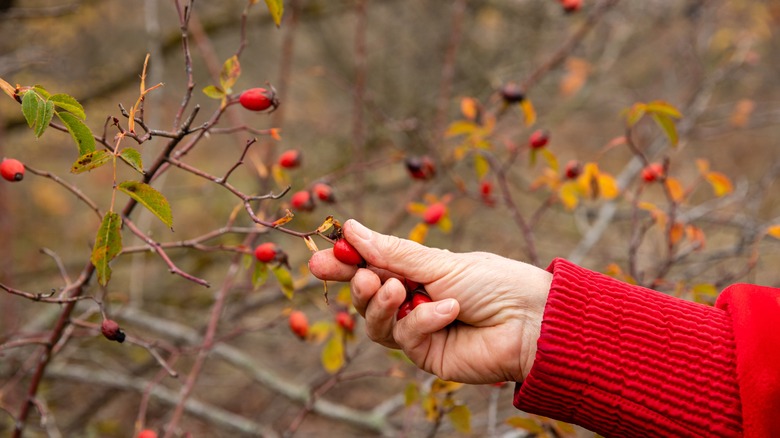Why You Should Save Leftover Rose Hips After Pruning Your Garden
Rose hips are the fruits produced by roses of all kinds, from wild to cultivated. Rose experts advise pruning rose hips (the fruits that form after roses finish blooming) from your rose bushes, to help encourage new buds. But these fruits should not just be discarded. They're edible, delicious, and full of vitamin C! Rose hips from wild or domestic roses grown in your garden can be made into tea or jam, or, left whole, can provide nutrition for birds and other backyard wildlife.
The many practical uses of rose hips are reason enough to save them after trimming. It's also perfectly fine to leave them attached and allow birds to feed on them directly, while adding striking winter color to your garden landscape. Wild rose hips in particular, especially the large hips produced on Rosa shrubs, are an important food source for many overwintering birds like blackbirds and thrushes. Cardinals and some smaller birds like waxwings enjoy the smaller rose hips found on dog roses (Rosa canina). Squirrels, rabbits, and bears are also known to eat wild rose hips.
Even though humans may be tempted to eat rose hips, they contain tiny seeds that can irritate our digestive tracts. So eating them whole is not a good idea, and if you want to eat them you should deseed them first, which can be time-consuming. But there are still ways we can prepare them to benefit from their nutrients.
The many uses of rose hips
Rose hips are known to have numerous health benefits and have been studied by the National Institutes of Health. This may explain why you see rose hips as a common ingredient in herbal tea blends. But rose hips are also a colorful and useful material for many household and garden projects. You can add them to potpourri or wreaths for gorgeous natural color.
While harvesting your rose hips, whether in your yard or foraging in the woods, be sure to leave some for the birds. These bright red berries attract many birds who happily eat them. They provide excellent food for birds who sometimes struggle to find nutritious seeds in the depths of winter. If you wish, you may prune the rose hips and put them in a spot that's accessible to your backyard birds and wildlife, such as in the trays of your bird feeders, or on your deck where the squirrels will be sure to find them.
The bright color and substantial shape of rose hips are not only visually pleasing but act as a beacon for wildlife looking for winter snacks. The height of your rose bushes is key to access and visibility to some wildlife, especially birds and climbing critters like squirrels. This makes the rose hips easier to find and eat than lower-growing plants that might get covered by snow.
How to harvest rose hips
The timing of when you harvest rose hips is important. Waiting until after the first frost means the rose hips will be sweeter and more flavorful. This is especially important if you plan to use the rose hips to make jam or mead. A brief period of freezing brings out this sweetness, but if you pick them before frost you can mimic nature's actions placing them in the freezer for a few hours before use.
You can use garden tools like bypass pruners or small garden snips to harvest the rose hips, or you can use gloved hands. Either way, be careful, especially on larger rugosa roses which can have very large and treacherous thorns. Keep the harvested rose hips in a brown paper bag if you're going to use them quickly; otherwise, you can freeze them to use later. If you're planning to dry the rose hips to use later in tea, there is no need to remove the seeds.
Whether you leave them attached to your roses through the winter, or prune them to use for household decor or projects, rose hips have an astonishing range of uses. Don't just clip them and toss them in your lawn bags or onto the compost heap: consider how they might be utilized for decor, food-preserving projects like jam or jelly, or nutritious cold-weather snacks for your local birds and wildlife.


